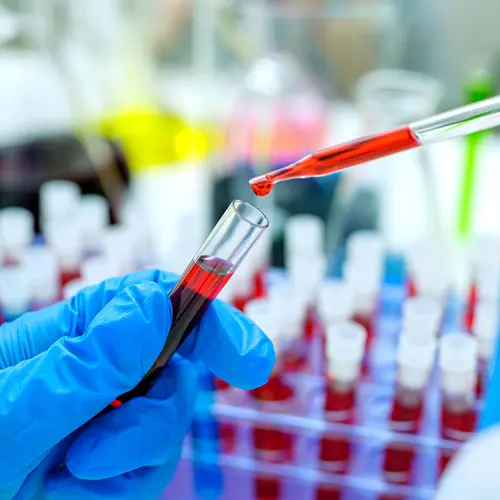TAC T-cell therapy is a new cancer treatment option. Researchers are studying it to treat both solid tumors and blood cancers, including multiple myeloma. If it gets FDA approval, this treatment would be a safer and more effective immunotherapy than another type of this treatment called CAR T-cell therapy. Immunotherapy is cancer treatment that uses your own immune system to lock onto and destroy things such as bacteria, viruses, and cancer.
The TAC molecule uses the natural biology of specific immune cells in your body called T cells to recognize and destroy cancer cells. Researchers first developed it as a possible treatment for HER2-positive breast cancers. HER2 is an antigen on breast cancer cells -- a protein on the cell’s surface that tells your immune system it’s a foreign substance that needs to be destroyed.
Clinical trials on TAC therapy for HER2-positive breast cancer started in April 2021 and are ongoing. Biotech companies are now looking at developing TAC T-cell studies for multiple myeloma as well.
Therapies Related to TAC T-Cell Therapy
To understand TAC therapy, it’s helpful to know more about other T-cell therapies that are related to it. These therapies all involve T cells modified in a lab, but the way they work to attack cancer cells is slightly different.
CAR T-cell therapy. CAR stands for chimeric antigen receptor. “Chimeric” means that the protein receptor has a different genetic code than the tissues in the rest of your body. A doctor takes a blood sample from your body through an IV and sends it to a lab. Technicians genetically alter the T cells in your blood sample so that they express a chimeric antigen receptor on their cell surface.
After the lab multiplies these altered T cells for a few weeks, your doctor puts them back into your bloodstream. The added receptor on the T cell’s surface helps your immune system “see” specific proteins on the surface of cancer cells. In multiple myeloma cells, this is a protein called BCMA. The modified receptor and BCMA proteins fit together like a key and a lock. Once they bind, the T cell destroys the cancer cell.
The FDA approved the first CAR T-cell therapy for multiple myeloma in March 2021 and a second in February 2022. Studies show these treatments can keep this cancer in check for at least a year.
The most recently approved CAR T-cell drug is ciltacabtagene autoleucel (Carvykti). For people taking it, the response rate is nearly 98%. This means almost all people taking it saw at least some reduction in the cancer in their bodies. For most people, this response lasted almost 2 years.
But these drugs also come with possible serious or even life-threatening side effects. They are also costly to make and can take up to a month to be ready for people who need them. This is because they are made specifically for the receptors on your personal cancer cells. Doctors continue to study improvements and additions to CAR T-cell therapy.
TCR therapy. TCR (T-cell receptor) therapy is also a T-cell immunotherapy. Like CAR T-cell therapy, it attaches a lab-made receptor to recognize surface proteins on cancer cells. But it also uses a T cell’s natural mechanisms to find and destroy them. This means it can be more specific about which cells to target.
Tumor cell proteins can look a lot like normal cell surface proteins, and often CAR T-cell therapies target these normal cells alongside cancer cells. This causes many of the serious side effects for people treating solid tumors with CAR T-cell therapy.
But in studies, TCR therapy has worked well in destroying blood, lung, breast, prostate, colon, bone, skin, kidney, ovarian, and cervical cancer cells while avoiding healthy cells. This means fewer side effects. Because of this, researchers began to explore and build on TCR mechanisms to create TAC T-cell therapy.
How TAC T-Cell Therapy Works
TAC T-cell therapy is a type of TCR therapy. (TAC stands for T-cell antigen coupler.) Doctors take a sample of your blood and send it to a lab where technicians add receptors to your T cells. They do this using a gene called the TAC transgene. This gene tells the cells to express the TAC molecule across the surface of the cell.
A TAC molecule can’t signal a cell on its own, but it can redirect them to use their natural TCR mechanism to target a cancer cell and destroy it. The T cell does this by recruiting small proteins called cytokines. They signal to enzymes that tell the cancer cell to die.
Because TAC molecules use a T cell’s natural mechanism, it lowers the chance that the T cells will keep attacking cells and cause problems with healthy cells. Researchers can also make custom TAC receptors to target different tumor types. These work for both solid tumors and blood cancers such as multiple myeloma.
Who Might Get TAC T-Cell Therapy?
When you have multiple myeloma that comes back (relapses), typically the chances of treating it successfully go down. Doctors turn to CAR T-cell therapy for people who have already received several (typically at least four) other types of treatment for their multiple myeloma.
By the time you qualify for a CAR T-cell therapy, your immune system has been working hard. Some doctors wonder whether it makes sense to try these therapies earlier in treatment, even as a first option. This would potentially mean a more robust immune system that might be able to work better with the immunotherapy drugs.

